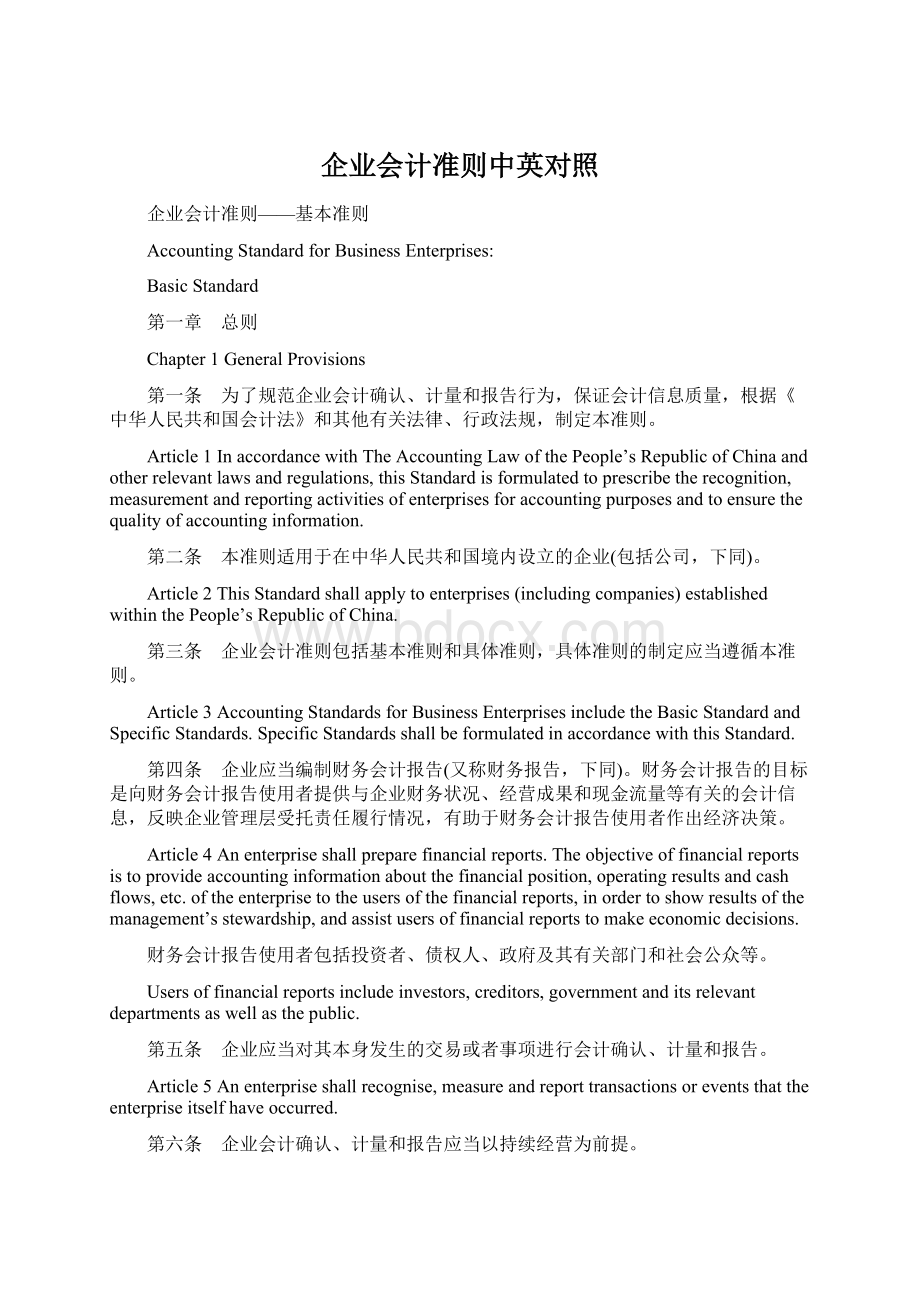 企业会计准则中英对照.docx
企业会计准则中英对照.docx
- 文档编号:11588540
- 上传时间:2023-03-19
- 格式:DOCX
- 页数:10
- 大小:22.24KB
企业会计准则中英对照.docx
《企业会计准则中英对照.docx》由会员分享,可在线阅读,更多相关《企业会计准则中英对照.docx(10页珍藏版)》请在冰豆网上搜索。

企业会计准则中英对照
企业会计准则——基本准则
AccountingStandardforBusinessEnterprises:
BasicStandard
第一章 总则
Chapter1GeneralProvisions
第一条 为了规范企业会计确认、计量和报告行为,保证会计信息质量,根据《中华人民共和国会计法》和其他有关法律、行政法规,制定本准则。
Article1InaccordancewithTheAccountingLawofthePeople’sRepublicofChinaandotherrelevantlawsandregulations,thisStandardisformulatedtoprescribetherecognition,measurementandreportingactivitiesofenterprisesforaccountingpurposesandtoensurethequalityofaccountinginformation.
第二条 本准则适用于在中华人民共和国境内设立的企业(包括公司,下同)。
Article2ThisStandardshallapplytoenterprises(includingcompanies)establishedwithinthePeople’sRepublicofChina.
第三条 企业会计准则包括基本准则和具体准则,具体准则的制定应当遵循本准则。
Article3AccountingStandardsforBusinessEnterprisesincludetheBasicStandardandSpecificStandards.SpecificStandardsshallbeformulatedinaccordancewiththisStandard.
第四条 企业应当编制财务会计报告(又称财务报告,下同)。
财务会计报告的目标是向财务会计报告使用者提供与企业财务状况、经营成果和现金流量等有关的会计信息,反映企业管理层受托责任履行情况,有助于财务会计报告使用者作出经济决策。
Article4Anenterpriseshallpreparefinancialreports.Theobjectiveoffinancialreportsistoprovideaccountinginformationaboutthefinancialposition,operatingresultsandcashflows,etc.oftheenterprisetotheusersofthefinancialreports,inordertoshowresultsofthemanagement’sstewardship,andassistusersoffinancialreportstomakeeconomicdecisions.
财务会计报告使用者包括投资者、债权人、政府及其有关部门和社会公众等。
Usersoffinancialreportsincludeinvestors,creditors,governmentanditsrelevantdepartmentsaswellasthepublic.
第五条 企业应当对其本身发生的交易或者事项进行会计确认、计量和报告。
Article5Anenterpriseshallrecognise,measureandreporttransactionsoreventsthattheenterpriseitselfhaveoccurred.
第六条 企业会计确认、计量和报告应当以持续经营为前提。
Article6Inperformingrecognition,measurementandreportingforaccountingpurposes,anenterpriseshallbeassumedtobeagoingconcern.
第七条 企业应当划分会计期间,分期结算账目和编制财务会计报告。
Article7Anenterpriseshallclosetheaccountsandpreparefinancialreportsforeachseparateaccountingperiod.
会计期间分为年度和中期。
中期是指短于一个完整的会计年度的报告期间。
Accountingperiodsaredividedintoannualperiods(yearly)andinterimperiods.Aninterimperiodisareportingperiodshorterthanafullaccountingyear.
第八条 企业会计应当以货币计量。
Article8Accountingmeasurementshallbebasedonunitofcurrency.
第九条 企业应当以权责发生制为基础进行会计确认、计量和报告。
Article9Recognition,measurementandreportingforaccountingpurposesshallbeonanaccrualbasis.
第十条 企业应当按照交易或者事项的经济特征确定会计要素。
会计要素包括资产、负债、所有者权益、收入、费用和利润。
Article10Anenterpriseshalldeterminetheaccountingelementsbasedontheeconomiccharacteristicsofthetransactionsorevents.Accountingelementsincludeassets,liabilities,owners’equity,revenue,expensesandprofit.
第十一条 企业应当采用借贷记账法记账。
Article11Anenterpriseshallapplythedoubleentrymethod(i.e.debitandcredit)forbookkeepingpurposes.
第二章 会计信息质量要求
Chapter2QualitativeRequirementsofAccountingInformation
第十二条 企业应当以实际发生的交易或者事项为依据进行会计确认、计量和报告,如实反映符合确认和计量要求的各项会计要素及其他相关信息,保证会计信息真实可靠、内容完整。
Article12Anenterpriseshallrecognise,measureandreportforaccountingpurposestransactionsoreventsthathaveactuallyoccurred,tofaithfullyrepresenttheaccountingelementswhichsatisfyrecognitionandmeasurementrequirementsandotherrelevantinformation,andensuretheaccountinginformationistrue,reliableandcomplete.
第十三条 企业提供的会计信息应当与财务会计报告使用者的经济决策需要相关,有助于财务会计报告使用者对企业过去、现在或者未来的情况作出评价或者预测。
Article13Accountinginformationprovidedbyanenterpriseshallberelevanttotheneedsoftheusersoffinancialreportsinmakingeconomicdecisions,byhelpingthemevaluateorforecastthepast,presentorfutureeventsoftheenterprise.
第十四条 企业提供的会计信息应当清晰明了,便于财务会计报告使用者理解和使用。
Article14Accountinginformationprovidedbyanenterpriseshallbeclearandexplicable,sothatitisreadilyunderstandableanduseabletotheusersoffinancialreports.
第十五条 企业提供的会计信息应当具有可比性。
Article15Accountinginformationprovidedbyenterprisesshallbecomparable.
同一企业不同时期发生的相同或者相似的交易或者事项,应当采用一致的会计政策,不得随意变更。
确需变更的,应当在附注中说明。
Anenterpriseshalladoptconsistentaccountingpoliciesforsameorsimilartransactionsoreventsthatoccurredindifferentperiodsandshallnotchangethepoliciesarbitrarily.Ifachangeisrequiredorneeded,detailsofthechangeshallbeexplainedinthenotes.
不同企业发生的相同或者相似的交易或者事项,应当采用规定的会计政策,确保会计信息口径一致、相互可比。
Differententerprisesshalladoptprescribedaccountingpoliciestoaccountforsameorsimilartransactionsoreventstoensureaccountinginformationiscomparableandpreparedonaconsistentbasis.
第十六条 企业应当按照交易或者事项的经济实质进行会计确认、计量和报告,不应仅以交易或者事项的法律形式为依据。
Article16Anenterpriseshallrecognise,measureandreporttransactionsoreventsbasedontheirsubstance,andnotmerelybasedontheirlegalform.
第十七条 企业提供的会计信息应当反映与企业财务状况、经营成果和现金流量等有关的所有重要交易或者事项。
Article17Accountinginformationprovidedbyanenterpriseshallreflectallimportanttransactionsoreventsthatrelatetoitsfinancialposition,operatingresultsandcashflows.
第十八条 企业对交易或者事项进行会计确认、计量和报告应当保持应有的谨慎,不应高估资产或者收益、低估负债或者费用。
Article18Anenterpriseshallexerciseprudenceinrecognition,measurementandreportingoftransactionsorevents.Itshallnotoverstateassetsorincomenorunderstateliabilitiesorexpenses.
第十九条 企业对于已经发生的交易或者事项,应当及时进行会计确认、计量和报告,不得提前或者延后。
Article19Anenterpriseshallrecognise,measureandreporttransactionsoreventsoccurredinatimelymannerandshallneitherbringforwardnordefertheaccounting.
第三章 资产
Chapter3Assets
第二十条 资产是指企业过去的交易或者事项形成的、由企业拥有或者控制的、预期会给企业带来经济利益的资源。
Article20Anassetisaresourcethatisownedorcontrolledbyanenterpriseasaresultofpasttransactionsoreventsandisexpectedtogenerateeconomicbenefitstotheenterprise.
前款所指的企业过去的交易或者事项包括购买、生产、建造行为或其他交易或者事项。
预期在未来发生的交易或者事项不形成资产。
“Pasttransactionsorevents”mentionedinprecedingparagraphincludeacquisition,production,constructionorothertransactionsorevents.Transactionsoreventsexpectedtooccurinthefuturedonotgiverisetoassets.
由企业拥有或者控制,是指企业享有某项资源的所有权,或者虽然不享有某项资源的所有权,但该资源能被企业所控制。
“Ownedorcontrolledbyanenterprise”istherighttoenjoytheownershipofaparticularresourceor,althoughtheenterprisemaynothavetheownershipofaparticularresource,itcancontroltheresource.
预期会给企业带来经济利益,是指直接或者间接导致现金和现金等价物流入企业的潜力。
“Expectedtogenerateeconomicbenefitstotheenterprise”isthepotentialtobringinflowsofcashandcashequivalents,directlyorindirectly,totheenterprise.
第二十一条 符合本准则第二十条规定的资产定义的资源,在同时满足以下条件时,确认为资产:
Article21AresourcethatsatisfiesthedefinitionofanassetsetoutinArticle20inthisstandardshallberecognisedasanassetwhenbothofthefollowingconditionsaremet:
(一)与该资源有关的经济利益很可能流入企业;
(a)itisprobablethattheeconomicbenefitsassociatedwiththatresourcewillflowtotheenterprise;and
(二)该资源的成本或者价值能够可靠地计量。
(b)thecostorvalueofthatresourcecanbemeasuredreliably.
第二十二条 符合资产定义和资产确认条件的项目,应当列入资产负债表;符合资产定义、但不符合资产确认条件的项目,不应当列入资产负债表。
Article22Anitemthatsatisfiesthedefinitionandrecognitioncriteriaofanassetshallbeincludedinthebalancesheet.Anitemthatsatisfiesthedefinitionofanassetbutfailstomeettherecognitioncriteriashallnotbeincludedinthebalancesheet.
第四章 负债
Chapter4Liabilities
第二十三条 负债是指企业过去的交易或者事项形成的、预期会导致经济利益流出企业的现时义务。
Article23Aliabilityisapresentobligationarisingfrompasttransactionsoreventswhichareexpectedtogiverisetoanoutflowofeconomicbenefitsfromtheenterprise.
现时义务是指企业在现行条件下已承担的义务。
未来发生的交易或者事项形成的义务,不属于现时义务,不应当确认为负债。
Apresentobligationisadutycommittedbytheenterpriseundercurrentcircumstances.Obligationsthatwillresultfromtheoccurrenceoffuturetransactionsoreventsarenotpresentobligationsandshallnotberecognisedasliabilities.
第二十四条 符合本准则第二十三条规定的负债定义的义务,在同时满足以下条件时,确认为负债:
Article24AnobligationthatsatisfiesthedefinitionofaliabilitysetoutinArticle23inthisstandardshallberecognisedasaliabilitywhenbothofthefollowingconditionsaremet:
(一)与该义务有关的经济利益很可能流出企业;
(a)itisprobabletherewillbeanoutflowofeconomicbenefitsassociatedwiththatobligationfromtheenterprise;and
(二)未来流出的经济利益的金额能够可靠地计量。
(b)theamountoftheoutflowofeconomicbenefitsinthefuturecanbemeasuredreliably.
第二十五条 符合负债定义和负债确认条件的项目,应当列入资产负债表;符合负债定义、但不符合负债确认条件的项目,不应当列入资产负债表。
Article25Anitemthatsatisfiesthedefinitionandrecognitioncriteriaofaliabilityshallbeincludedinthebalancesheet.Anitemthatsatisfiesthedefinitionofaliabilitybutfailstomeettherecognitioncriteriashallnotbeincludedinthebalancesheet.
第五章 所有者权益
Chapter5Owners’Equity
第二十六条 所有者权益是指企业资产扣除负债后由所有者享有的剩余权益。
Article26Owners’equityistheresidualinterestintheassetsofanenterpriseafterdeductingallitsliabilities.
公司的所有者权益又称为一股东权益。
Owners’equityofacompanyisalsoknownasshareholders’equity.
第二十七条 所有者权益的来源包括所有者投入的资本、直接计入所有者权益的利得和损失、留存收益等。
Article27Owners’equitycomprisescapitalcontributedbyowners,gainsandlossesdirectlyrecognisedinowners’equity,retainedearningsetc.
直接计入所有者权益的利得和损失,是指不应计入当期损益、会导致所有者权益发生增减变动的、与所有者投入资本或者向所有者分配利润无关的利得或者损失。
Gainsandlossesdirectlyrecognisedinowners’equityarethosegainsorlossesthatshallnotberecognisedinprofitorlossofthecurrentperiodbutwillresultinchanges(increasesordecreases)inowners’equity,otherthanthoserelatingtocontributionsfrom,orappropriationsofprofitto,equityparticipants.
利得是指由企业非日常活动所形成的、会导致所有者权益增加的、与所有者投入资本无关的经济利益的流入。
Gainsareinflowsofeconomicbenefitsthatdonotariseinthecourseofordinaryactivitiesresultinginincreasesinowners’equity,otherthanthoserelatingtocontributionsfromowners.
损失是指由企业非日常活动所发生的、会导致所有者权益减少的、与向所有者分配利润无关的经济利益的流出。
Lossesareoutflows
- 配套讲稿:
如PPT文件的首页显示word图标,表示该PPT已包含配套word讲稿。双击word图标可打开word文档。
- 特殊限制:
部分文档作品中含有的国旗、国徽等图片,仅作为作品整体效果示例展示,禁止商用。设计者仅对作品中独创性部分享有著作权。
- 关 键 词:
- 企业会计 准则 中英对照
 冰豆网所有资源均是用户自行上传分享,仅供网友学习交流,未经上传用户书面授权,请勿作他用。
冰豆网所有资源均是用户自行上传分享,仅供网友学习交流,未经上传用户书面授权,请勿作他用。


 《雷雨》中的蘩漪人物形象分析 1.docx
《雷雨》中的蘩漪人物形象分析 1.docx
